Why grind your own spices when there are so many pre-ground spices conveniently available for purchase at the grocery store, spice shops, and big box stores? Because freshly ground spices tastes infinitely better than purchased pre-ground stuff. That's because as soon as you grind spices, they start releasing their oils. Flavor and aroma slowly dissipate like a blow up cushion with a tiny leak. Keep the spices whole and grind them in batches so you have fresh, bold flavors at the ready.
Good spices cost a lot too and are valuable! They were once held in high esteem because they were so rare. During medieval times, people used pepper to pay rent, taxes, and even a dowry. Peppercorns were prized currency. Christopher Columbus's initial chief mission in sailing to Asia was to acquire spices for Europe. He came across chiles in America and thought he'd found pepper, hence the confusing name chile pepper.
So, if you're goin to invest in good spices, do your best to start from whole spices and grind them yourself! Ditto for spice blends. Unless something is super special, you can make your own Viet-style curry powder or Chinese five-spice powder. Grind your own peppercorns for bursts of pungent, spicy sweet heat. I keep a jar of "recently ground black pepper" on my counter for cooking. The pepper grinder is for salads or other flourishes.
But, what to use to efficiently grind spices? You need a tool of some sort. In this post, I offer my favorite three options for grinding spices.
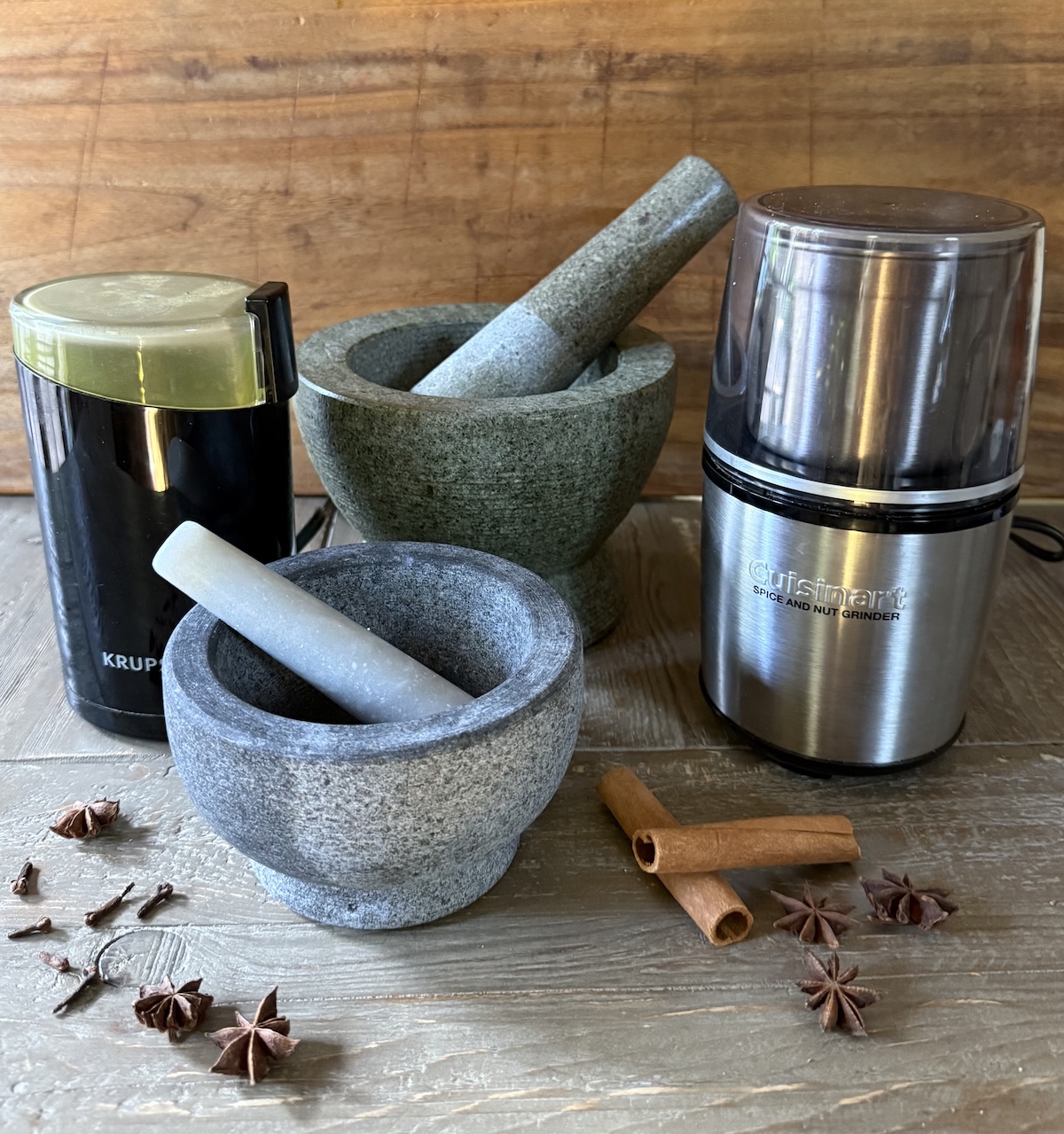
Which spice grinder should you buy or use?
It depends on the amount, what you're grinding, and how much physical energy you have. Each option has its pros and cons. I use each of these -- mortar and pestle, a blade coffee grinder, and a spice-and-nut grinder in my kitchen. I've lived with them for a while. Here's why and what you may choose for your own needs.
Mortar and pestle
I own marble, ceramic, wooden, and stone mortars and pestles. The two below are the ones I used most often because they are not too small, are not too heavy, and they do the job well for spices, marinades, guacamole, and even pesto!

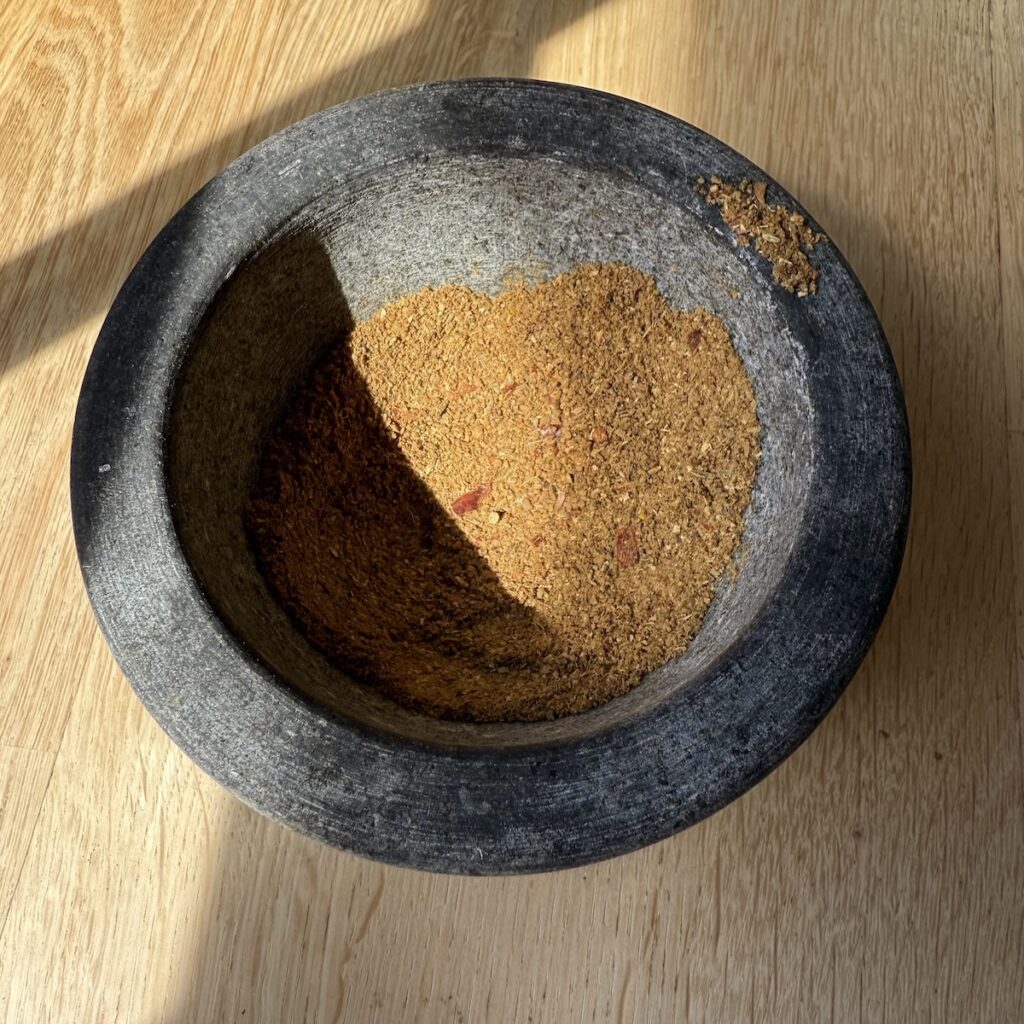
- PROS: Granite mortar and pestles are affordable and long lasting. The bigger one above is from Thailand and is considered a medium size one. It's about 7 inches across from edge to edge. The pestle is big and heavy so you don't have to exert too much effort. It does the work for you. I use the big pestle in the small granite mortar to make faster work of spices. I use the granite mortar and pestle for smallish spice batches and pastes when I don't want to wash extra dishes and/or I want old fashioned, unplugged cooking. When you use a mortar and pestle, you get to better observe and control the transformation of ingredients. The curry powder that I hand pounded has some largish lingering bits that I needed to pull out and pound separately. That is normal. But texturally, the result was similar to the Cuisinart grinder discussed below.
- CONS: Granite mortar and pestles can be heavy. Select one that you can pick up easily and move around your kitchen counter with out hurting yourself. You'll be living with it for a long time. Always use a granite mortar atop something to absorb shock. I prefer a double layer of ½-inch (1.25cm) thick cork trivets. I know my countertop will be protected. Traditional Asian cooks set big mortars on the kitchen floor and work closely to the floor. You don't need to do that.
- HOW TO BUY: A small mortar (about 1.5 cup | .4L capacity) is good for small jobs. More versatile is a medium mortar (2-cup | .5L capacity). Pick up the mortar to test if you and lift it easily. Shop for granite mortar and pestles at Thai, Cambodian, and Vietnamese markets. Asian cookware shops, such as M.V. Trading, often sell Thai mortar and pestles like the larger one in above photo. The smaller mortar in the above photo was an online purchase (choose the polished option to avoid discoloration). Expect to pay between $25 and $40, depending on size and source.
- PESTLE CHEAT: If you already have a mortar, cheat and buy a biggish granite "replacement" pestle. It'll work wonders on a small to medium mortar. The little white marble pestle in the above photo is dinky and not very efficient for pounding.
Coffee grinder
For years, I used an inexpensive blade coffee grinder dedicated to grinding spices and toasted rice. (We have a separate burr coffee grinder for coffee beans.) It works well for many reasons, but has drawbacks. Mine is stained yellow from turmeric. If that happens to you, leave the lid outside for the sun to bleach out the stain.
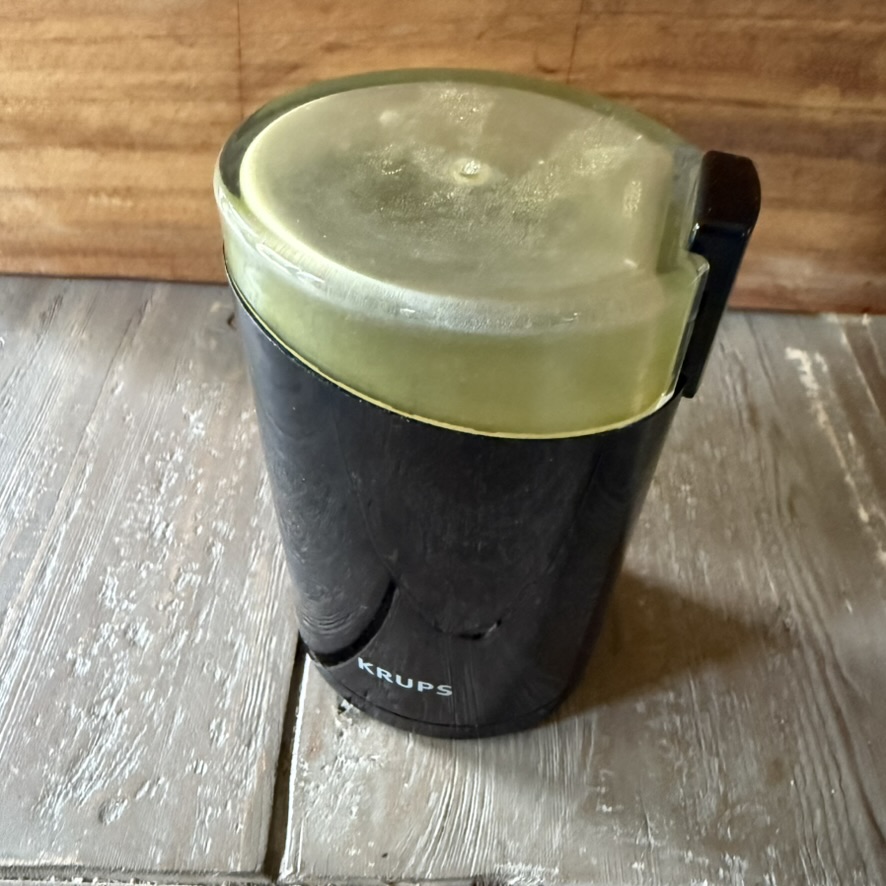

PROS: A basic blade coffee grinder like the Krups will last for many years. It is affordable and small so it stays out of the way. It works fast so control by pulsing, or you will get a fine grind faster than you think. If you want fine grinds all the time, grinders made by Krups, Cuisinart, or Black and Decker are a great option. The Black And Decker is positioned as a coffee and spice grinder!
CONS: To clean the interior, grind 1 tablespoon of raw rice, then brush and wipe out the chamber with a damp paper towel. It is not ideal but you do not want to immerse the unit in water. You cannot do very big batches. It is noisy. If you want one that's less noisy and has a removal container, consider the Krups "Silent Vortex" model. See the video below for usage tips.
HOW TO BUY: Expect to pay $20 to 65, depending on quiet level and blade design. Krups (basic), Amazon, Crate and Barrel | Black and Decker, Amazon, Target | Cuisinart, Amazon, Target | Krups (silent blade + removal chamber), Amazon, Home Depot
Spice and nut grinder
How about a machine that puts spices up front and center? For well over a year, I've been using the Cuisinart Spice and Nut Grinder. I like this machine a lot because what it produces is akin to spices that have been hand pounded. Additionally, it's great for lots of spices, like this Vietnamese curry powder.
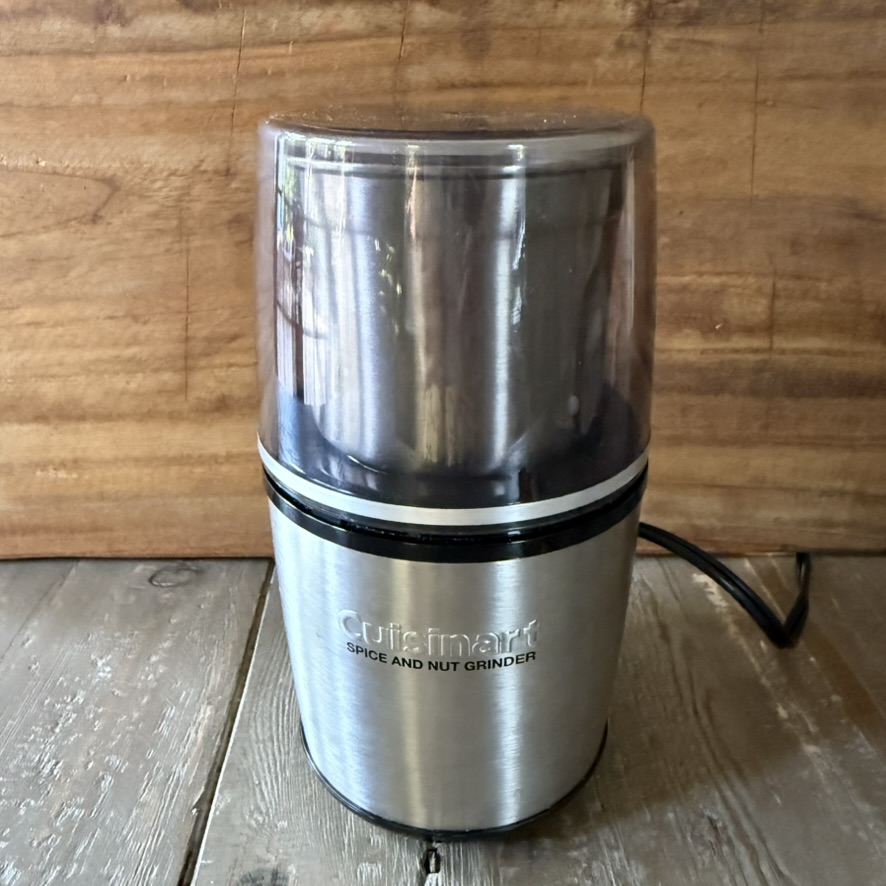
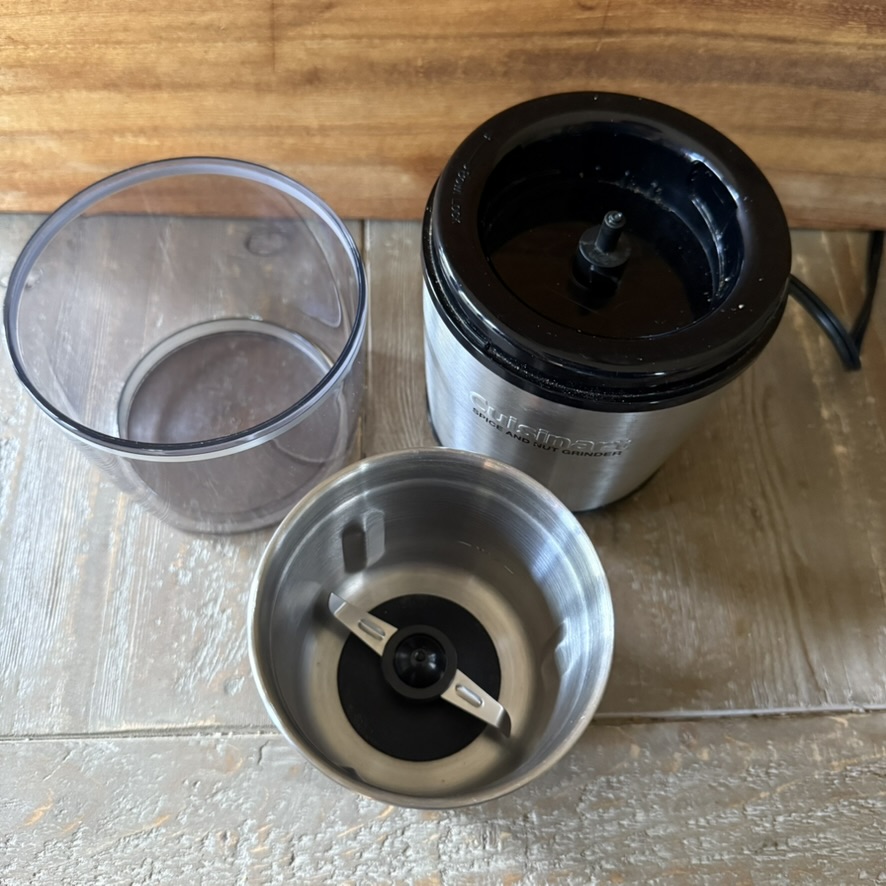
PROS: The Cuisinart Spice and Nut Grinder is relatively quiet, has a biggish chamber (hold up to 3 ounces (90g) of material, and does a grind that most closely mimics results from the mortar and pestle. That's to say, spices have a certain handcrafted quality, though you can keep the machine going to obtain a powdery texture. If you push the grinder to work too hard, it has an auto shut off to force you to let the motor cool and rest.
CONS: It's slightly bigger than the blade coffee grinder. When you attach the chamber, it feel flimsy but is not. The blade wiggles a bit but that's so it can handle ingredients of various textures and shapes. Do not attempt to shake the grinder because it will cause material to come out of the chamber.
HOW TO BUY: Cuisinart, Amazon, Home Depot Expect to pay about $50.
Your tips for grinding spices?
What do you use? Share your knowledge so we may all learn from one another!

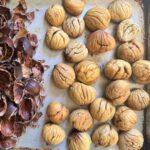

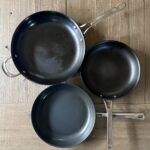

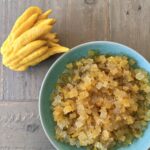

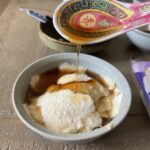

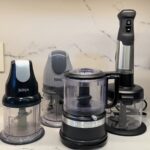
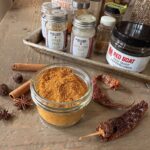

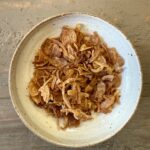




helen says
I tried using our old Krups knockoff coffee grinder for spices and ended up with big chunks of cloves left in the mix unless I made a big batch. I think the partially ground spices just stayed on the bottom under the reach of the blades. Do you have that issue with yours, or any tips for avoiding it?
(Incidentally, the lid for my coffee-turned-spice grinder has a sandblasted texture from the impact of whirring spices.)
Andrea Nguyen says
You could try holding on to the "Krups" motor and lid tightly and shaking it as you're operating it. That may help distribute the whole spices so they have better contact with the blade.
My Krups lid is not sandblasted feeling. That has happened to me in the past though. When the lid chipped and I didn't know where the plastic went, I replaced that particular unit. I mostly grind peppercorns in the Krups nowadays so I don't have to wash it. It's a small luxury for me that I understand most people do not have.
If the spices continue to get stuck under the blade, despite your shaking the unit, consider getting a new one.
Mary Khan says
I have used the cuisinart grinder for many years but want to stress that the compartment and lid should only be hand washed and not put through the dishwasher. I ruined a few of these within months and had to replace them by putting them through the dishwasher. I stopped doing that and my current one has been around for a good 4-5 years
Andrea Nguyen says
Mary -- that's invaluable information! I've never put mine in the dishwasher so I would have never thought that the machine would impact the lid and chamber that way. And you still returned to the Cuisinart ginger. That's validation for it.
Katharina says
I use and old-fashioned Zassenhaus coffee grinder from about the 1950s for grinding my spices. I wouldn't want to miss it. It can't quite grind things to an extremely fine powder but a slightly coarser consistency is actually what I prefer. I wouldn't recommend buying it new though - the same model is still around 75ish years later but it's hideously expensive now.
Andrea Nguyen says
That is so wonderful to know that a coffee grinder can last that long, Katherina! We had a burr coffee grinder that lasted about 15 years and then decided to poop out. German manufacturing is meant to last. We have a hand-crank coffee grinder for travel or in case we lose power and that thing has been with us for about 10 years. I don't know if it will be good 60 years from now!
Thank you for sharing your experience!